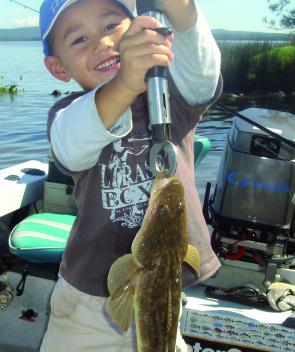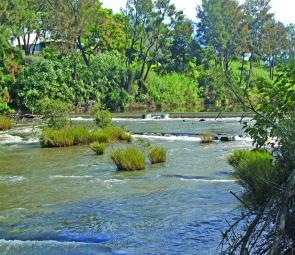Notes: FACTBOX TO GO WITH PIC Zann609_2
It’s gonna stop raining this month, isn’t it? Please, say it will! How cruel to think there are places in this parched country where we can say something like this and sincerely mean it.
Evans Head had recorded its total average annual rainfall by Anzac Day and, unfortunately, this typically wet autumn hasn’t looked like fading into a dry winter/spring just yet.
The only joy is that there hasn’t been a drastic flood with its associated fish kills – just a steady 10mm to 30mm each day with a few ‘teaser’ days of perfect autumn weather in between.
The Richmond, Evans and Brunswick rivers have all been fresh and brown except for their final few kilometres, which have housed bream, flathead, whiting and increasing numbers of blackfish, along with patches of jewfish at various times.
This month bass and estuary perch will also turn up, the perch well within earshot of the ocean and often in sight of it, while the bass will be a fraction higher in the system where there’s a hint of salinity suitable for their spawning activities.
Those bass will have to travel a long way downstream this year to find that right mix of salt, so there’s a fair chance there’ll be some very mixed bags in the lower estuaries. Bream, perch, blackfish, bass, flathead, jewfish and whiting won’t quite be rubbing shoulders but they won’t be an enormous distance apart.
This is a great time for fishing the beaches, provided the professional hauling crews don’t disgrace themselves by rounding up every school of mullet, bream, blackfish, tailor and even salmon that swims by.
The local outfits are pretty selective and have to live in the communities where they fish, but the travelling crews don’t care about anything but themselves and it’s time this archaic practice of hammering travelling schools into oblivion was ended.
Offshore weather patterns usually mean June is calm on the beaches and there are plenty of chances at fish as they move through.
There should be more baitfish, including small white pilchards (whitebait) and frogmouth pilchards (anchovies) as well as some shoals of blue pilchards (sardines). Schools of tailor and bream will be working these, and when the bait works a bit wider the snapper, mackerel tuna and bonito will also take their toll.
There’ll be plenty of vehicle traffic on the beaches, which have been quite eroded in places with plenty of undercut dunes and steep beach sections. So drive carefully and try to stay put at high tide, rather than further erode the dunes by driving over the fragile grasses that hold the sand together.
If things go according to plan, passing schools of mullet and blackfish will also have some decent jewies shadowing them. Big lures and big slab or head baits could start some fireworks on mulloway and sharks.
We’ll see good numbers of humpback whales migrating up the coast this month, too, meaning there should be plenty of shots at cobia as the whales come past.
I used to think it was just me who saw a correlation between the whales and increased cobia encounters so I’m relieved to think some others see the links.
Cobes seem to love hanging with all kinds of big stuff, like big sharks and mantas and what’s bigger than a whale? I’m thinking there’s some sort of energy-saving free ride business going on with this association, rather than a feeding pattern.
WEIR TO GO
The Manyweathers Weir, between the road and rail bridges over the Richmond River at Casino, is due to be pulled down this month by State Water.
This is certainly the next logical step in rehabilitating the river so fish can move more freely. After removal of the old Norco Weir a couple of kilometres downstream almost two years ago, migrating bass in Spring were able to travel unhindered as far as the Manyweathers Weir, where they encountered a serious obstacle in their quest to return to the headwaters.
Fish from upstream, including those swept over the wall of Toonumbar Dam, usually ride a flood or a fresh over all the obstacles to reach the more saline water where they spawn.
The Manyweathers obstacle emerges in drier times, typically in spring when the bass want to move back home and the mullet and eel fingerlings seek freshwater habitat for that section of their life cycles.
Although fish were able to negotiate the rocky shallows downstream, the weir itself proved a far more difficult barrier and only expensive and extensive modifications (which no one wanted to pay for on a redundant structure owned by State Water) would assist.
With fish passage more effective on the 3m-high Jabour Weir about 1.5km upstream, removal of the Manyweathers Weir would allow much more successful fish access.
There were plenty of local knockers before the Richmond Valley Council took down the Norco Weir but none of their dire predictions amounted to a hill of beans.
In fact, the river has never looked better or more natural and the numbers of fish that moved up to Manyweathers last season was exceptional.
However, this weir became the next bottleneck, concentrating hungry, migrating fish in vulnerable shallows where they could be easily exploited by the wrong people. At least anyone who fished there in daylight was operating in plain view of everyone crossing the bridge.
The weir is named in honour of the town’s longest-serving mayor, Richmond Manyweathers. With a Christian name like that, it would be wonderful to have something else around the river carry his name through this century and beyond.
Reads: 1484
Nigel Schultz with a Richmond River flathead. There’s no need to travel too far upstream for them at the moment.

The Manyweathers Weir on the Richmond River between the road and rail bridges at Casino should be dismantled this month, removing yet another obstacle for migrating fish.

Not all the bream are big in the winter. That’s a 2” grub lure!




